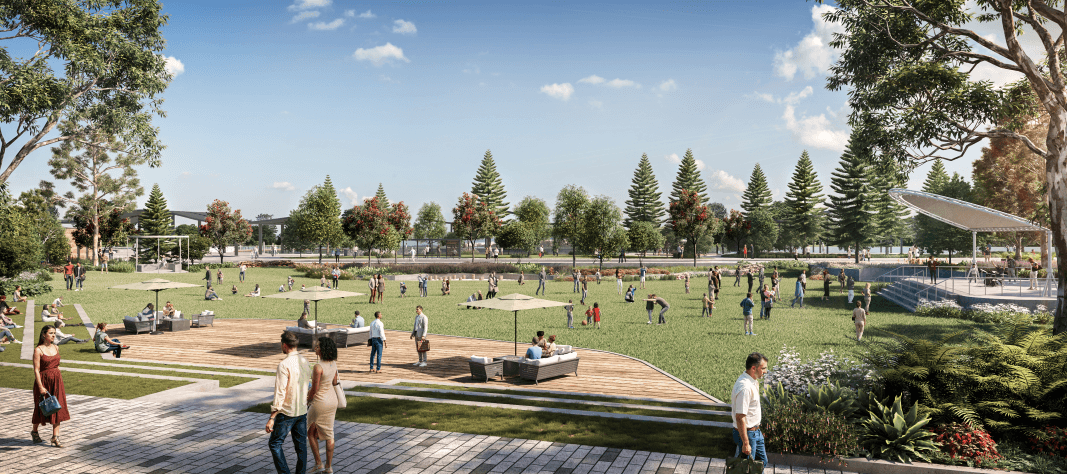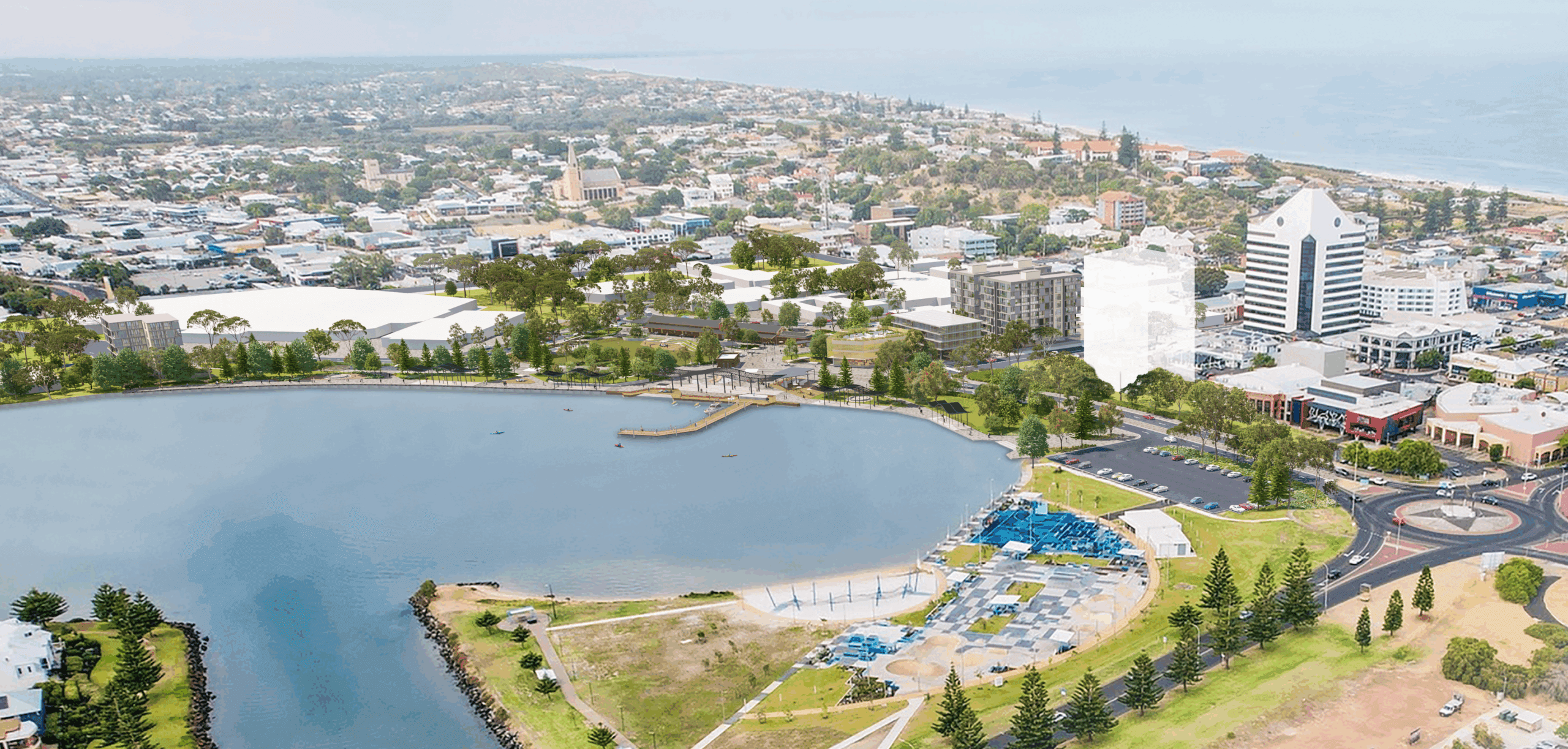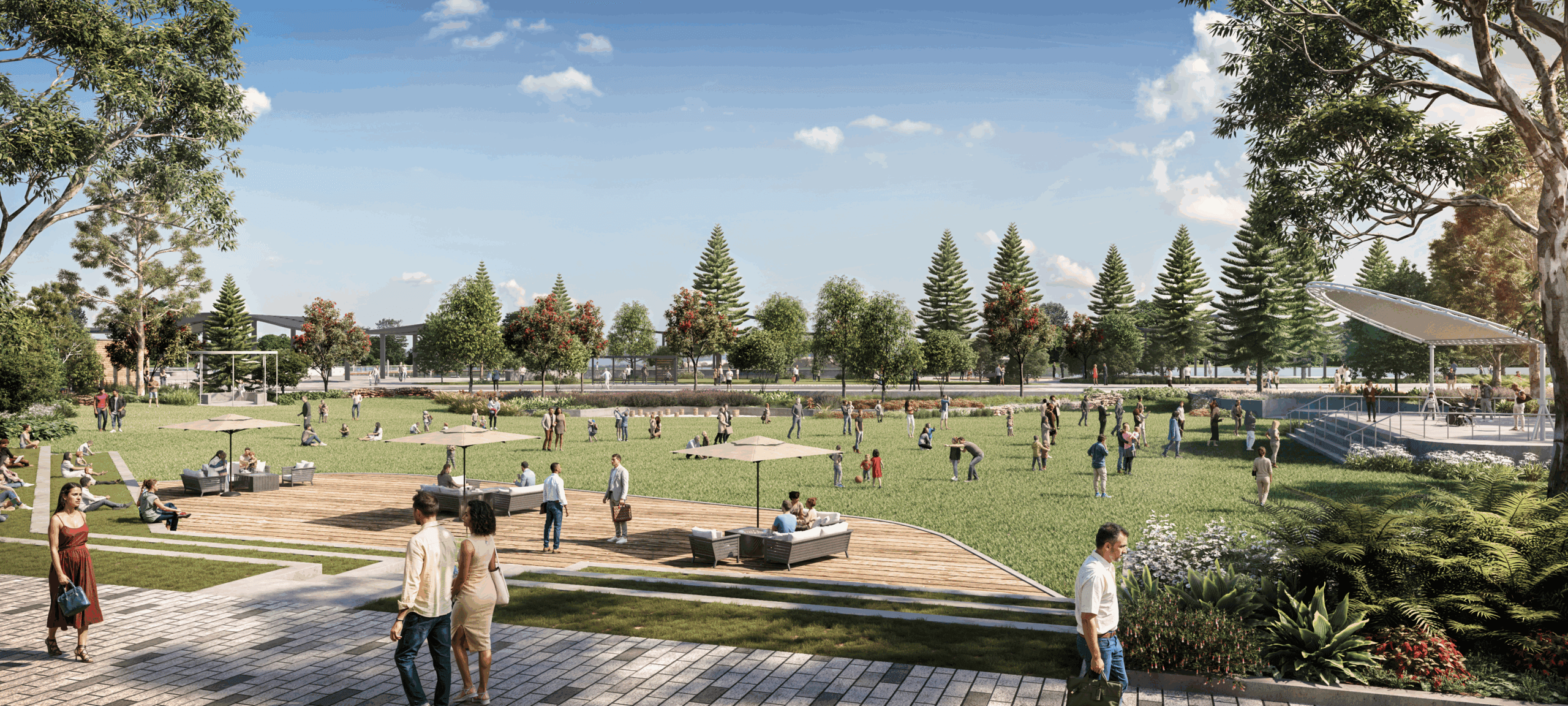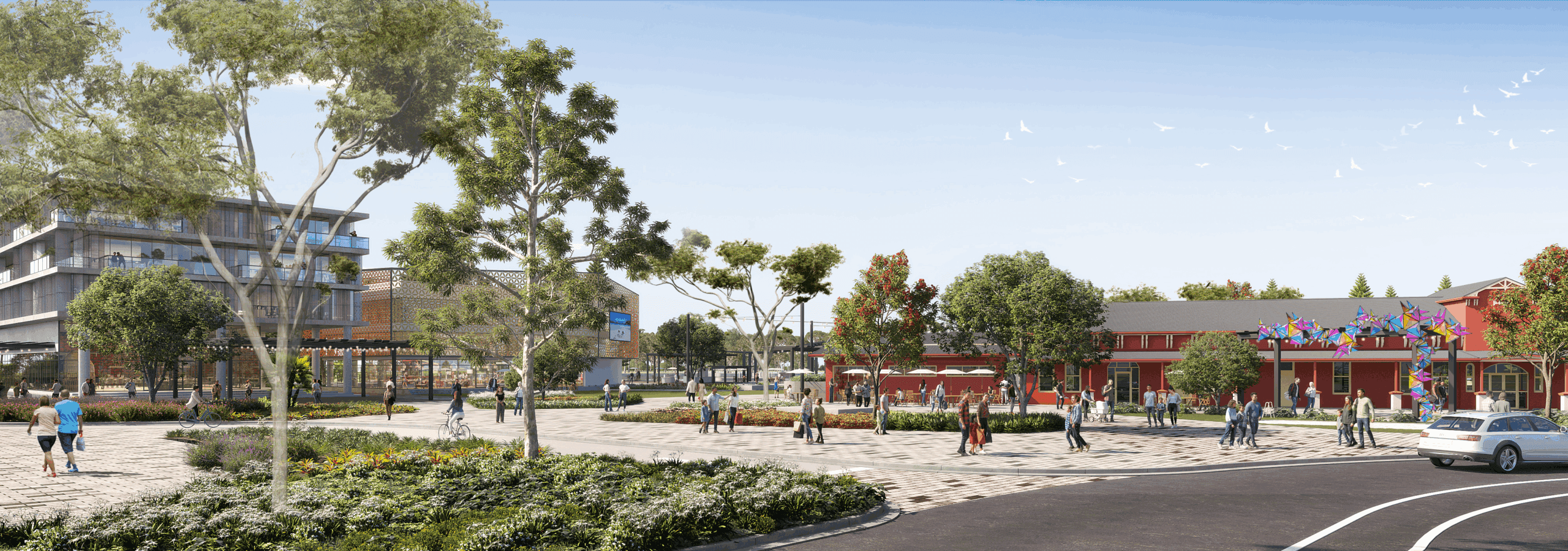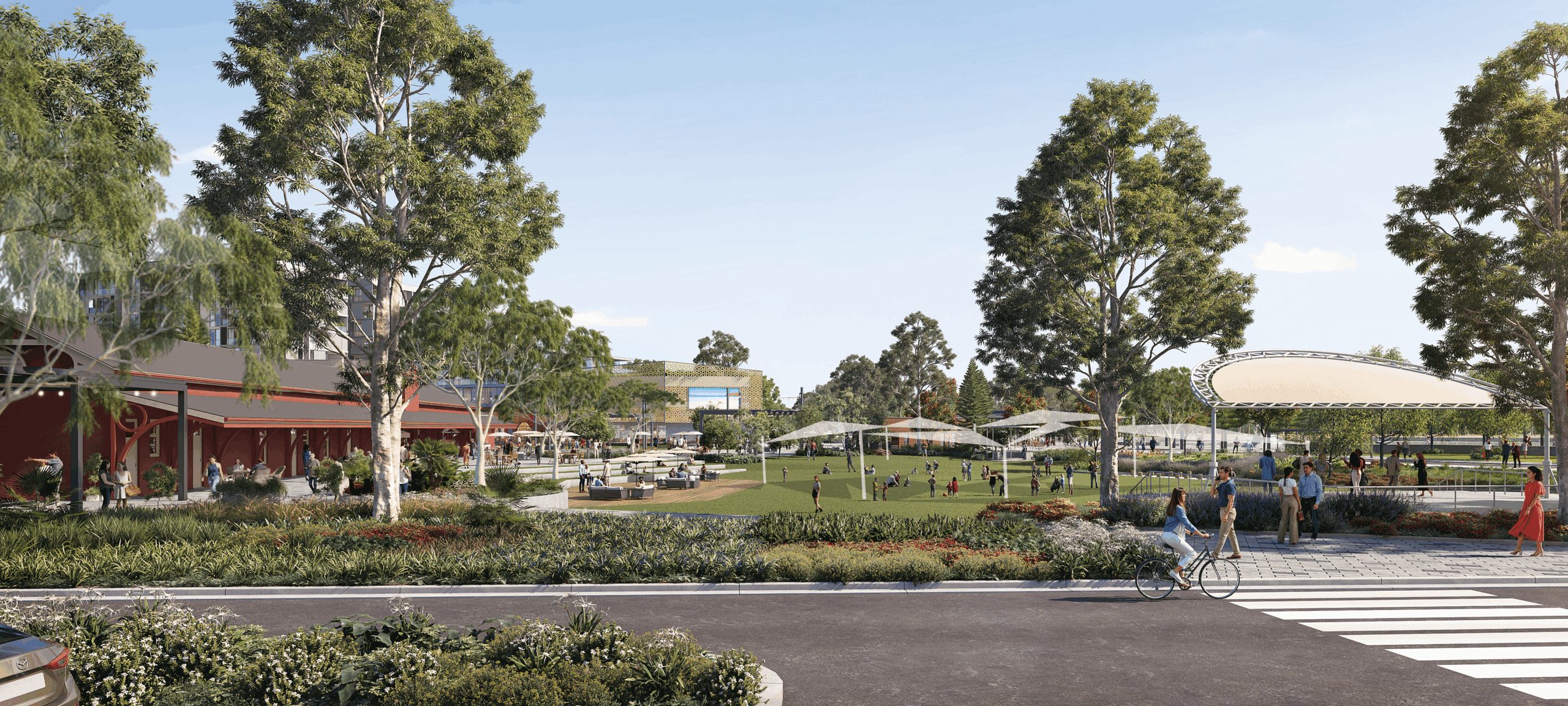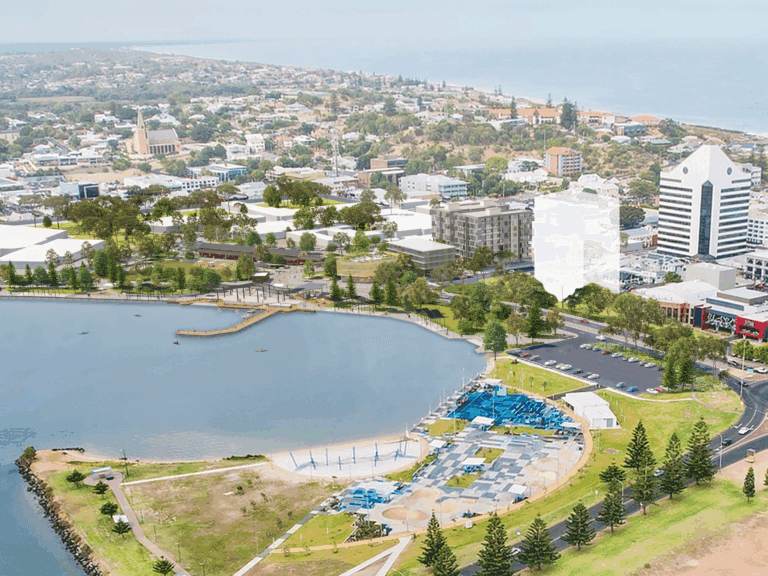Published 26 August 2025, updated 27 August 2025
The future of Bicentennial Square is taking shape, with community and stakeholder engagement now underway based on a draft masterplan.
Project timeline
- Start
- 16/05/2024
- Project start
- 16/05/2024
- State Government commits $100K to project
- 16/05/2024
- City allocates $50k to project
- 23/07/2024
- Project planning and technical studies
- 01/09/2024
- Stakeholder and community engagement
- 06/12/2024
- Council endorses phase two community engagement
- 29/07/2025
- Draft masterplan revealed
- 26/08/2025
- Community engagement underway
- 26/08/2025
This iconic and much-loved City Centre precinct is set to become Bunbury’s most vibrant and inclusive public space, connecting the City Centre with the Leschenault Inlet waterfront through modern amenities and adaptable spaces for year-round events of all sizes.

The draft masterplan has been shaped by extensive community and stakeholder engagement between November 2024 and January 2025, when strong support was shown for transforming Bicentennial Square into a vibrant, connected and flexible public space.
The masterplan is guided by nine key strategic moves that shape its overall vision and structure. Below is a summary of the nine key moves (please check out the masterplan for full details).
Bicentennial Square Nine Key Strategic Moves
There are six key precinct components proposed in the masterplan. These are:
- Event Lawn – a flexible urban event space for gatherings and performances.
- Station Forecourt – featuring adaptive reuse of heritage buildings and improved amenities.
- Central Plaza – mixed-use building with commercial, community, and alfresco activation opportunities.
- Central Foreshore – integrating waterfront activation including jetty and public art.
- Symmons Street – earmarked for inner-city residential and commercial development.
- Foreshore South – identified as a future residential development site.
Planning to date has included detailed traffic modelling and analysis of five design options for Blair Street to ensure the best outcome for Bunbury. The preferred approach reduces Blair Street to two lanes between Symmons and Haley streets at 40 km/h, supporting traffic calming, improving pedestrian safety with new crossings, and maintaining overall network performance to create a safer, more accessible City Centre.
The traffic modelling included a peak hour demonstration. Results show that the network could accommodate an additional 40 per cent increase in traffic before any impacts would begin.
Bicentennial Square History
Bicentennial Square was formed to provide an attractive public open space for the community following removal of the railway marshalling yards in 1985.
The historic old railway building was constructed in 1905 and – along with the separate ablution block building – is currently a heritage-listed building.
The concept for Bicentennial Square arose out of the State Government policy document, ‘Bunbury 2000’ which was developed in 1983 with the formation of the South Development Authority (now South West Development Commission). It was built in 1987-88.
The opportunity for the development of a city square emerged from the redevelopment of the former railway marshalling yards. The removal of the railway tracks and infrastructure opened up vistas from the City Centre through to the Leschenault Inlet foreshore.
Bicentennial Square was developed by the City and encompasses the former railway station (now a bus transit centre). The area was built on land reclaimed from the estuary and provides a footpath link to many sites along the inlet.
The Square has proved a popular venue for community entertainment and a spectator point for sporting and community events.
In 2000, the now Graham Bricknell Memorial Music Shell was constructed in memory of former councillor and deputy mayor of Bunbury, Graham Bricknell.

What’s happening now
In May 2024, the State Government and Member for Bunbury Don Punch announced $100,000 towards a detailed precinct plan. The City also allocated $50,000 in its 2024-25 Annual Budget.
The City has now allocated $500,000 in its 2025-26 Budget and will continue to investigate further funding opportunities.
The Bicentennial Square Precinct Plan project aligns with the stated vision, purpose and top priorities of the City’s Strategic Community Plan (SCP). We know that City Centre development and activation is one of our community's highest priorities and we are proud to continue to address this community priority through this project.
There will be a number of opportunities for community input to ensure that the Bunbury community is able to help influence the planning of this important civic space.
Community Engagement
The draft masterplan reflects extensive consultation with a diverse range of stakeholders, including government agencies, industry leaders, and community representatives. Key contributors include:
- Public Transport Authority
- Department of Planning, Lands and Heritage
- South West Development Commission
- Bunbury Geographe Chamber of Commerce and Industry
- Regional Development Australia
- ECU Creative Tech Village
Together, these voices have helped shape a shared vision for a vibrant, inclusive, and future-ready city centre.
Community engagement will continue to be a major part of the Bicentennial Square project.
Encompassing the beautiful area positioned between our City Centre and the Leschenault Inlet, this project aims to create a vibrant, sustainable, and inclusive space that reflects our community’s values and priorities. This is an exciting opportunity and one that our local community, businesses owners and visitors can influence and enjoy.
This next phase of consultation will include online engagement, drop-in and pop-up sessions, and targeted workshops with the First Nations community, youth, accessibility and inclusion advocates, business representatives, and government stakeholders.
Check out the community engagement portal and complete the survey!
We once again thank all community members for sharing their ideas, feedback and considerations in November and December 2024, helping inform this draft masterplan. Our community’s insights are crucial in shaping a space that meets our collective needs and aspirations.
The heart of our city, the precinct will prioritise accessibility, safety and comfort, creating an urban oasis and redefining the area as a landmark of pride that showcases Bunbury’s rich history, culture and the region’s produce.
Watch this space for further updates and opportunities to have your say.
Frequently Asked Questions
Bicentennial Square has long been an important City and community asset at the heart of Bunbury’s City Centre. Based on community feedback, key priorities include enhancing the square’s infrastructure, amenities, and programming to create a more welcoming, inclusive, and activated destination that is connected to both the City Centre and water.
By investing in the redevelopment of the precinct, the City aims to restore Bicentennial Square as a focal point of community life – a place that celebrates Bunbury’s identity, supports economic activity, and provides a safe and activated space for people to come together.
This project is a strategic economic investment to ensure this area of our City Centre can continue serving the community for years to come.
The City is committed to working collaboratively with residents, businesses, and stakeholders to shape a revitalised Bicentennial Square that reflects the community’s vision and aspirations.
The Bicentennial Square precinct masterplan covers approximately 4.55 hectares on the eastern edge of Bunbury’s City Centre. The precinct stretches south to the Bunbury Rowing Club, north to the Koombana Drive roundabout, east to the Leschenault Inlet waterfront, and west to Victoria Street. The precinct masterplan is divided into six distinct, but not exclusive components. Each of these key precinct components contributes to the overall creation of a vibrant City Centre destination.

Key precinct components:
- The Event Lawn
- Station Forecourt
- Central Plaza
- Symmonds Street
- Central Foreshore
- Foreshore South
Bicentennial Square was originally named to mark Australia’s Bicentenary in 1988 and presents an opportunity for reconciliation. With the upcoming bicentenary of European settlement in WA, the City is exploring a new name that reflects the precinct’s role as the heart of Bunbury.
Through consultation, the City aims to celebrate our multi-cultural community and collaboratively select a new name for the Bicentennial Square precinct.
To enhance pedestrian connectivity and strengthen the relationship between the City Centre and waterfront. Past strategic plans such as the Leschenault Inlet Masterplan have recommended reducing Blair Street to two lanes between Stirling Street and Koombana Drive.
The key objectives are to improve safety and comfort for pedestrians, create a stronger visual and physical connection between the city and waterfront, enable new development opportunities, and allow the street to be easily closed off for events.
Vehicle speeds will be slower, but traffic flow will be maintained between key roads.
In addition to the lane reduction, the City will introduce pedestrian crossings, traffic calming measures, and landscaping to further protect and engage pedestrians along Blair Street. The goal is to transform this area into a multipurpose, people-focused street environment that is attractive for all ages and abilities, whether for daily use or large events.
Traffic studies support this approach, with current modelling showing that single-lane configurations do not impact traffic flow in the area.
To better activate the space for all of the community, the bus station will be relocated to an alternative central CBD location. Public Transport Authority (PTA) is currently working with the City and identify potential locations for further development.
The City is working closely with the Public Transport Authority (PTA) to identify suitable bus stop locations along the periphery of the Bicentennial Square precinct. This will ensure ongoing public transit access while allowing the core area to be reclaimed as a vibrant, pedestrian-focused destination.
There is currently bus stops identified on the masterplan for Bicentennial Square ensuring accessibility to the area via public transport is still available to our community and visitors.
Homelessness is a complex issue that affects communities across the country, and the City continues to work closely with State Government agencies, service providers, and community organisations who lead in this space.
Our role is often one of support, coordination and advocacy, ensuring that Bunbury is a safe, inclusive and accessible city. We also contribute through broader initiatives such as community grants, place activation, and infrastructure improvements that help create welcoming public spaces and support vulnerable members of our community.
The City remains committed to being part of the solution and will continue to engage with partners and explore opportunities to support homelessness responses.
Please read more on what the City is doing in this space here.
This is envisioned as a long-term priority project for the City, with actions and implementation spanning between one to 10 years.
Community consultation is an important part of the Bicentennial Square project. We are committed to keeping our community informed through each stage of the development, with information continuously updated and shared through our City website, community connect portal, social media and other channels.
The revitalisation of Bicentennial Square and the introduction of inner city living, commercial, and community uses will create a vibrant, engaging space that will enhance activation along the commercial shopfronts and an increase in our nighttime economy.
The precinct is envisioned to complement Bunbury’s City Centre and be a key driver for reinvigorating the city, creating a central attraction for all to enjoy.
As with all City planning, parking is an important consideration. The goal of this project is to create a vibrant and pedestrian-friendly environment. The Bicentennial Square redevelopment will take into consideration the City’s Parking Strategy, which will identify existing usage patterns in high-need areas and provide a strategy for the supply of short, medium, and long-term parking in and around the City Centre. This includes looking at location options and/or the potential of a multi-deck carpark.
The project encourages a diverse range of activities and uses throughout the day and night, keeping the area activated. This will include opportunities for inner city living, cafes, restaurants, public events, and recreational amenities that draw people to the waterfront. A jetty has been proposed for public access, fishing and recreational activities – including a creative solution to movie on the water nights and fireworks at the estuary.
The creation of accessible, welcoming public spaces, including enhanced lighting will ensure the waterfront is an inclusive, safe gathering place for people of all ages and backgrounds across the Bunbury community.
The introduction of inner city living in the CBD and the activation of a new hotel at Lot 3 Blair Street will enhance the liveability, safety and nighttime activation of the area.
The City acknowledges that the Graham Bricknell Memorial Music Shell is a meaningful piece of community infrastructure. In consultation with the family of Graham Bricknell, the City plans to dismantle the music shell and store it, until an appropriate relocation site can be determined. Removal of the current structure will provide an opportunity for active land use that better serves the community’s needs in this space.
A new, more lightweight soundshell structure will be constructed to host events and performances in the precinct, backing onto Haley Street. This revised design will provide a flexible stage setup that can be adjusted for event needs.
Bunbury Visitor Centre is currently located in the Bunbury Museum and Heritage Centre on Arthur Street, walking distance from Bicentennial Square. This location is based on a Council decision, which also included it being reviewed as part of the Bicentennial Square project.
Following community engagement, there may be an opportunity for the Visitor Centre to be relocated to the new precinct once it is complete.
The City initially received funding to develop this plan through a $100,000 grant from the State Government, alongside a $50,000 investment from the City. As this will be an important community asset, the City has committed a further $500,000 in its 2025-26 Budget for the detailed planning stage.
The City is committed to seeking external funding for delivery of the project, such as grants, sponsorships, private investment and partnerships. The community will be kept informed of the stages and funding arrangements as we move forward.
The City recognises the cultural value that the existing historic buildings and features bring to Bunbury’s City Centre.
Through sensitive interventions like the adaptive reuse of the heritage-listed Old Railway Station building, as well as the integration of interpretive public art and signage, the City is committed to honouring the precinct’s storied past.
By working closely with heritage experts and the community, the City will ensure this transformation is respectful and celebrates Bunbury’s origins. A key component of this project is the sensitive restoration of the heritage-listed Old Railway Station building as the central statement of the precinct.
The draft masterplan has been developed in line with the City’s Disability Access and Inclusion Plan (DAIP). Ongoing consultation with the community and CoDAP will ensure the team is able to address the diverse needs and requirements of our community and visitors.
The City views this project as an opportunity to upgrade the precinct and investigate further possibilities and solutions to accessibility challenges. There is a deliberate focus on creating a space that is truly inclusive and welcoming for the entire community.
Some of the key accessibility features being incorporated include:
- Ramps and smooth, barrier-free pathways
- Ample lighting to improve visibility
- Dedicated ACROD parking spaces
- Other inclusive design elements like seating, wayfinding, and sensory-friendly spaces
By embedding accessibility as a core priority, the City aims to create a revitalised Bicentennial Square precinct that can be fully enjoyed and accessed by people of all abilities.
The precinct will be abundant with open, community spaces with multi-layer options for shade, such as trees, art and built structure.
As outlined in the sustainability and environmental initiatives, the project will focus on increasing the tree canopy with native species to provide natural shade and support local biodiversity. This will be combined with strategically placed architectural shade structures, such as distinctive arbour elements along the waterfront promenade and throughout the public realm.
The greening and landscaping strategy will also incorporate waterwise plantings to create a pleasant, naturalistic setting for people to gather, relax, and enjoy the outdoors. These shaded, open community spaces will allow for a variety of uses, from structured events to informal recreation and social connection.
By prioritising both open, flexible areas and diverse shade solutions, the revitalised Bicentennial Square precinct will offer an inviting, climate-responsive public space that encourages people to linger, explore, and fully engage with their community.
Sustainability and environmental responsibility are part of the core principles guiding the Bicentennial Square precinct redevelopment. The project aligns with the Coastal Hazard Risk Management and Adaptation Plan (CHRMAP) to proactively address climate change impacts. The precinct will incorporate a range of initiatives across different focus areas:
Sustainable Transport and Urban Infrastructure
The precinct will enhance pedestrian and cycling connections, ensure universal accessibility, and incorporate sustainable technologies like solar-powered lighting and electric vehicle charging.
Greening and Biodiversity
The design will increase tree canopy with native species, use waterwise landscaping, and partner with the community to improve soil health and support local habitats.
Climate Resilience
Climate-resilient materials, water sensitive design features, and smart irrigation systems will help the precinct adapt to and educate about climate change impacts, in alignment with the CHRMAP.
Community, Culture and Wellbeing
Flexible public spaces, cultural interpretation, and community-led sustainability activities will foster an inclusive, healthy environment that celebrates the area’s heritage.
